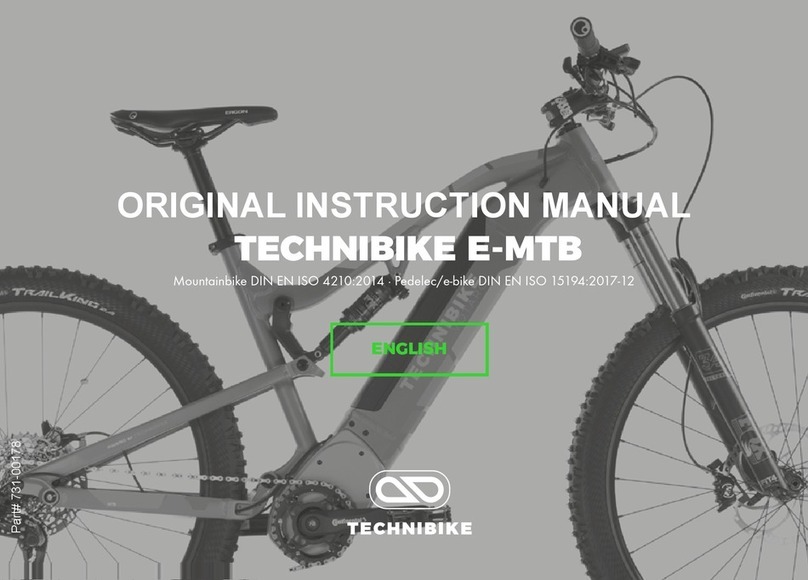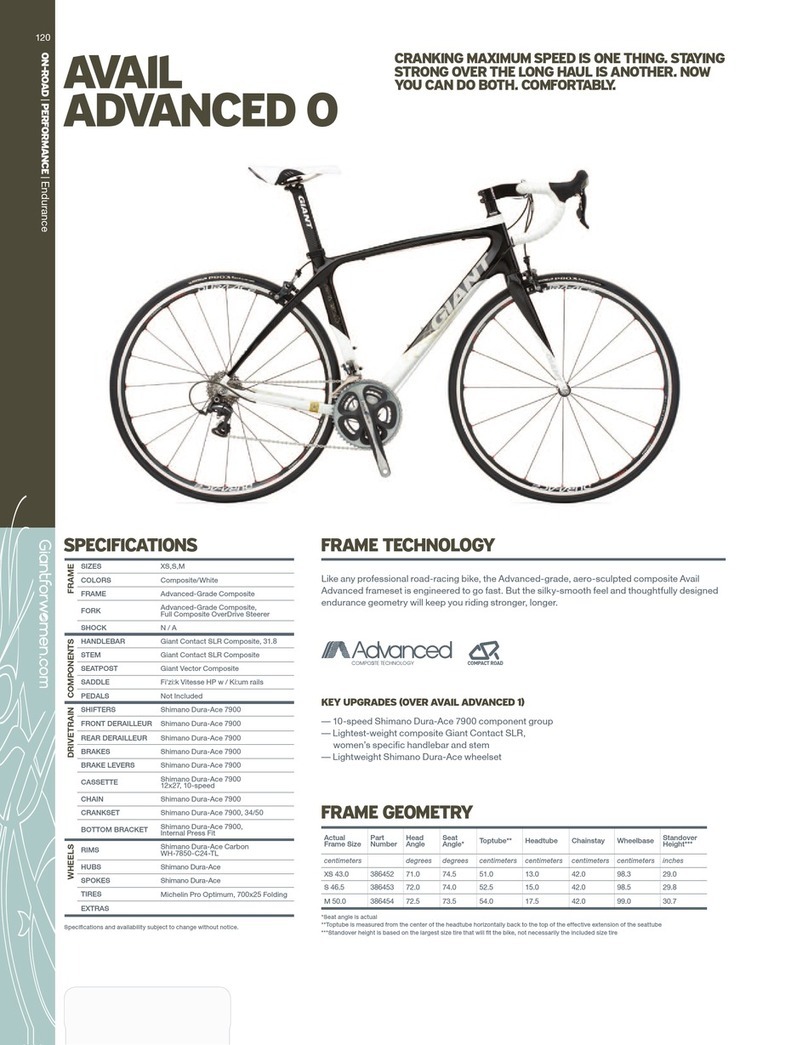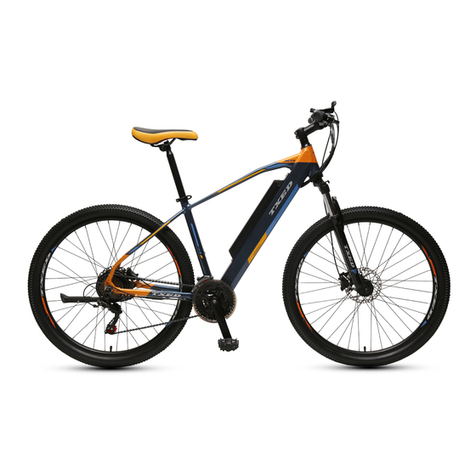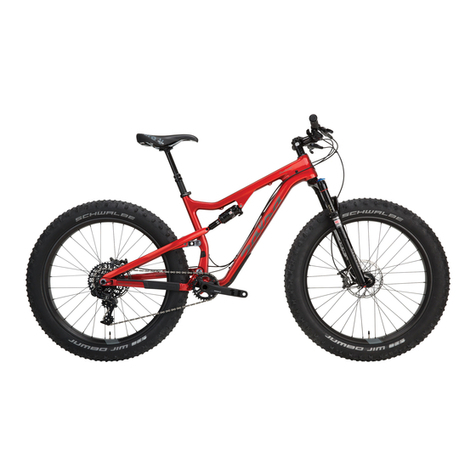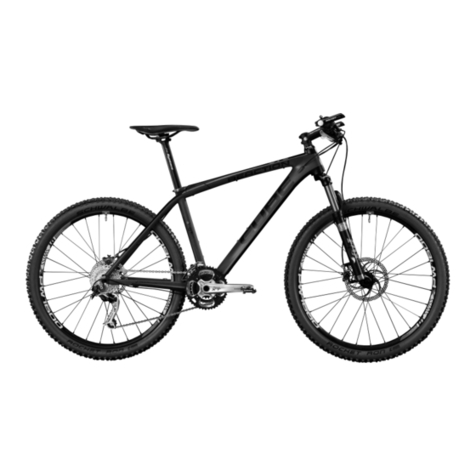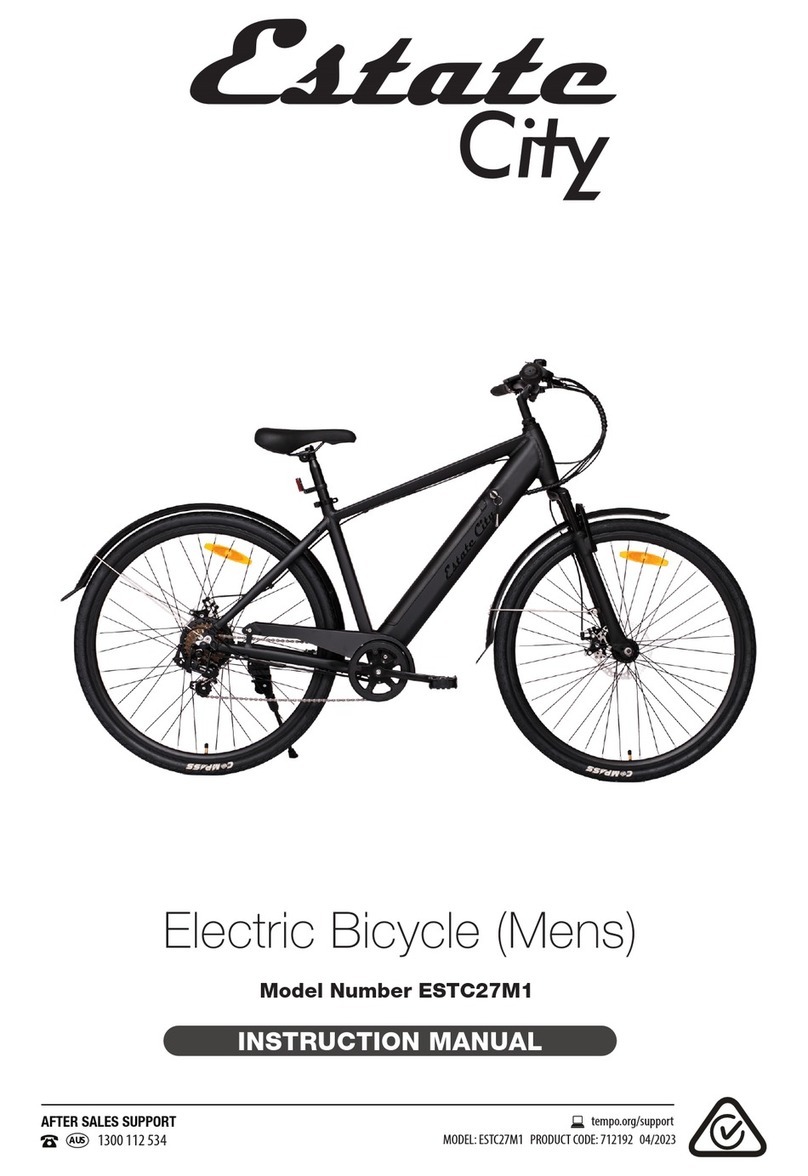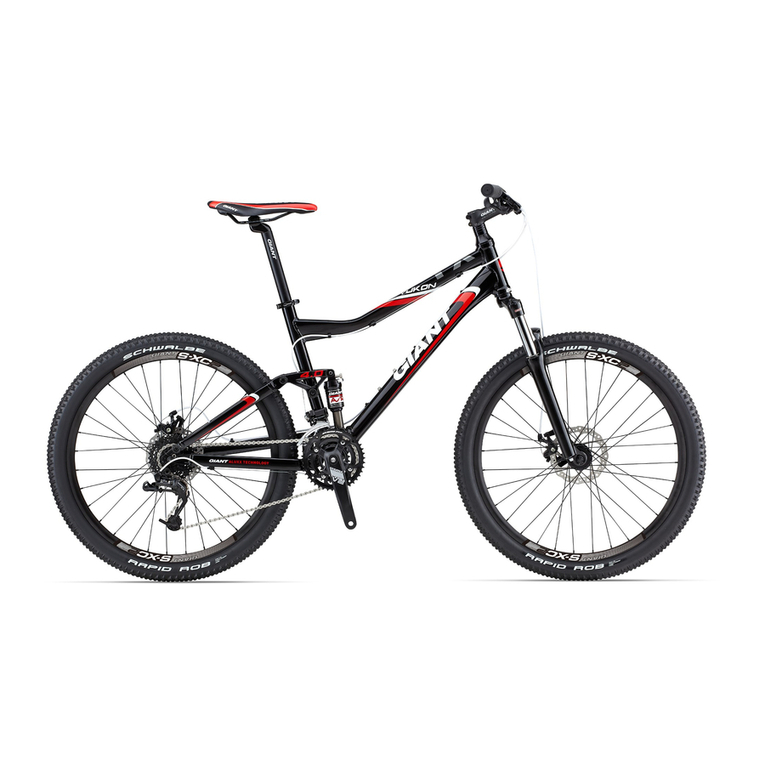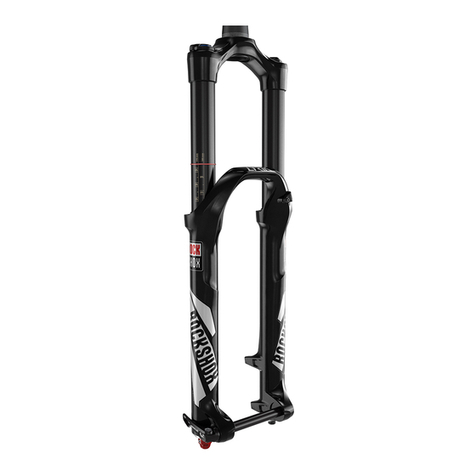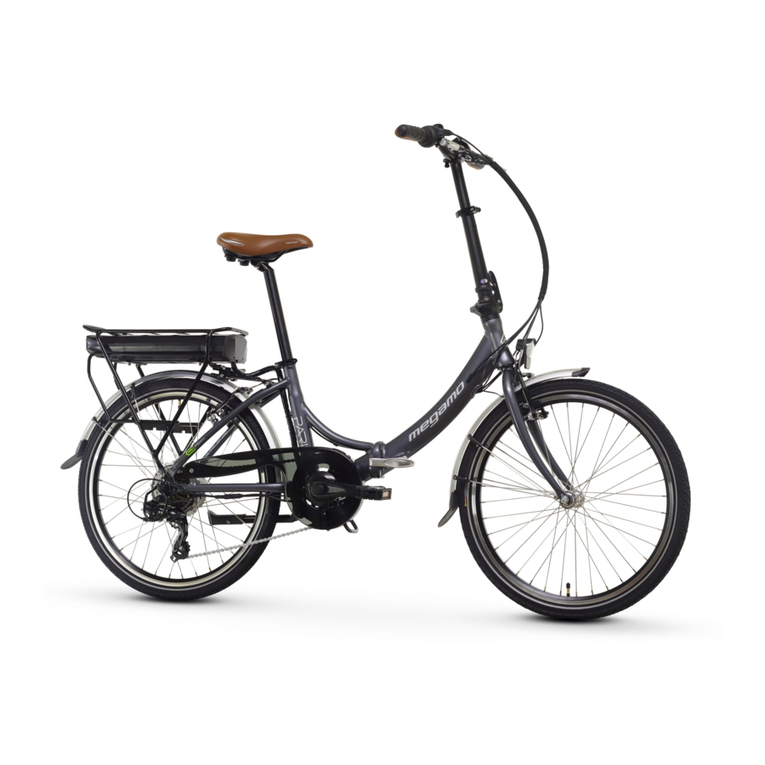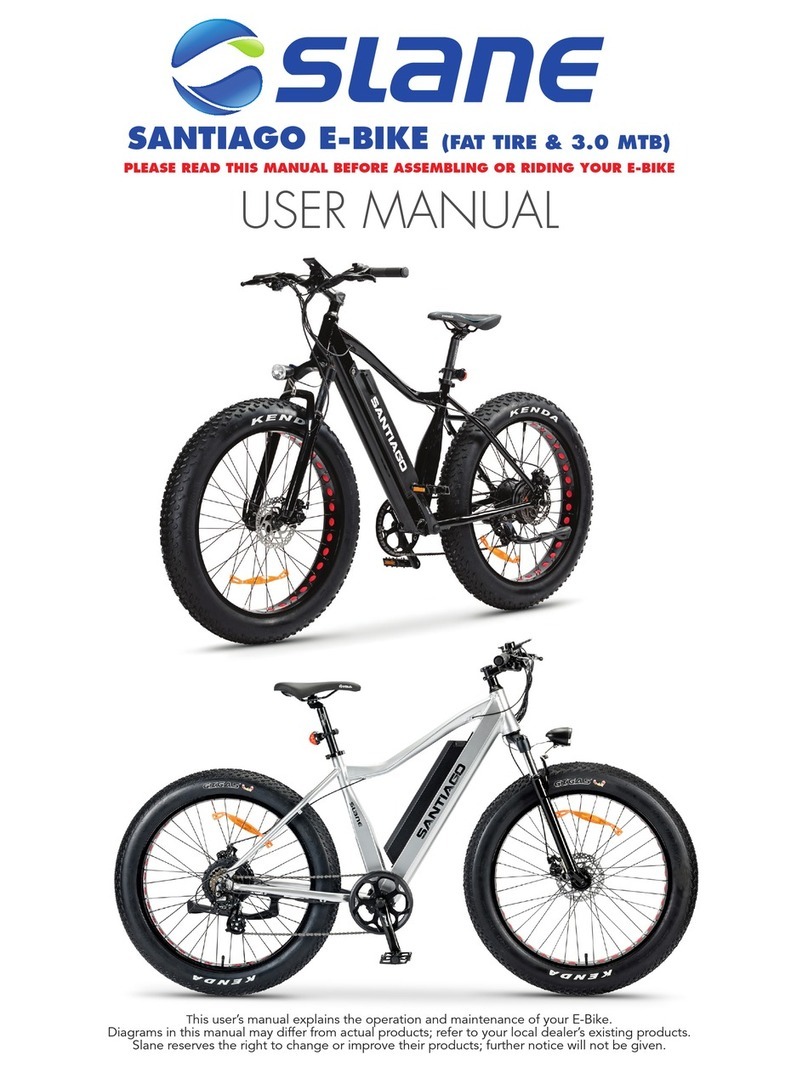GoPlus SP35311 User manual

CANADA
UNITED STATES
AUSTRALIA
JAPAN
SPAIN
UNITED KINGDOM RUSSIA
GERMANY
ITALY
FRANCE
TIPS:
Your suggestions and comments for Costway are really important to us!
We sincerely solicit you to go back to our shop and leave a good rating in just a
simple click. It would be quite encouraging if you could kindly do so like below:
February 24, 2018
Great product so far. Fast delivery, easy setup, and working without any issues.
Great products so far
With your inspiring rating, Costway will be more consistent to offer you
EASY SHOPPING EXPERIENCE, GOOD PRODUCTS and EFFICIENT SERVICE!
US office:Fontana
UK office:Ipswich
USER'S MANUAL
ROAD BIKE
SP35311

1. SAFETY
2. ASSEMBLY
3. ADJUSTMENT
3.1. Wheels
3.2. Headset (threaded and threadless)
3.3. Handle bar
3.4. Saddle, seat post
3.5. Pedals
3.6. Front derailleur
3.7. Rear derailleur
3.8. Rim brakes
3.9. Mechanical disc brakes
3.10. Hydraulic disc brakes
3.11. Tyres
4. MAINTAIN YOUR BICYCLE
4.1. Before every ride
4.2. Once a week (about 100-200 km distance run)
4.3. Once a month (about 500-800 km distance run)
4.4. Once a season
5. GUIDE TO GENERAL RULES
5.1. Recommended tools for service and repair
5.2. Frame size choice
5.3. Seat (saddle) adjustment
5.4. Apparel
5.5. Gear shift
5.6. Chain
5.7. Storage
CONTENTS
_________________________________________________________
P. 1
P. 2
P. 5
P. 6
p. 7
P. 7
P. 7
P. 8
P. 9
P. 11
P. 12
P. 12
P. 13
P. 13
P. 14
P. 14
P. 14
P. 15
P. 15
P. 15
P. 15
P. 16
P. 16
P. 16

P. 1
Present manual covers
brand biycles.
1. SAFETY
_________________________________________________________
1.1. ATTENTION! Please remember cycling can be a hazardous activity.
1.2.
Before each ride
check the bike
as described in Section 4.
1.3.
When riding, use individual means of protection.
Wear a helmet to protect your
head from injury, glasses will cover your eyes from dust and insects, gloves will save
your hands in case of fall.
1.4. Most countries and regions have their
own national regulations for cyclists. Here are the most crucial rules:
1.4.1. Use appropriate hand signals.
1.4.2.
1.4.3. If you’re in a team while on the road cycle one by one.
1.4.4. Protect yourself (try to forecast unexpected). Remember: You are not always
visible; though cycling becomes more popular, many drivers do not know
bicycle signals.
1.5.
Be careful when cycling on roads with dangerous surface.
Please be careful
while riding on gravel roads.
1.5.1. Make sure you’re allowed to ride there. Not all parks and private places are
opened for cyclists.
1.5.2. Put on protective apparel, including helmet, glasses and gloves.
1.5.3. Stubs, stones, potholes make ground cycling dangerous.
1.5.4. When going down slow down, moving your body backwards and down-
wards; it’s advisable to use rear brake.
1.5.5. Avoid rocks, branches and hollows.
1.5.6. Consider others. Use the bell to warn them you’re on the way.
1.6.
Use brakes with care.
Always keep a safe distance when stopping behind other ve-
hicles or objects. Braking distance and power should correspond to road conditions
depending on weather. Use both brakes at the same time and avoid front brake
overusing.
1.7.
Protect yourself.
Always be ready to face risk. Please remember you are less visible
to other cyclists, bikers and pedestrians than a car. Always be prepared to stop or
skirt.
1.8. Watch the road.Though road conditions and tracks design have recently become
better you should be always aware. You can meet pits, drains, low edges, etc on your
way. Cross the railway cautiously at the angle of 90 degrees. In case you don’t feel
1.9.
Watch the parked cars when passing by.
You can easily get into trouble in case
a car drives suddenly away or a car door is suddenly opened on your way. For your
safety it’s advisable to use the alarm bell.
1.10.
Be careful when driving at night time.
Your bicycle is equipped with required re-
-
is focused on them. We also advise you to set light equipment on your bicycle and
wear bright clothes to be seen on the road. The key point is to see and to be seen.
Please use numerous and various gadgets for that.
1.11. Mind wet weather.Any brakes no matter the design don’t function same way in
wet and dry weather. That is why one should stick to safety rules. When it’s wet out-
side your well adjusted and oiled brakes still require an increased lever pressure and
a longer braking distance. It will take you more time to stop. Besides, wet weather
leads to bad view (for you and car drivers) and worsens road adherence. Slow down
when turning on wet road. Greasy leaves and hatches can be dangerous as well.
1.12.
If you use additional equipment and make technical changes to your bike
(child
-
tions and applicable standards into account.
1.13.
Never leave your bike unattended to prevent theft.
2. ASSEMBLY
_________________________________________________________
2.1. Take your bike out of the box releasing it from packing.
2.2. Install the front wheel. Make sure the directional tyres go in the arrow marking direc-
2.3. Install the stem and the handlebar on the fork rod. Depending on the headset type,
install the star nut and tighten the screw with torque of 3-5 N/m or tighten the lock-
ing screw with torque of 25 N/m.
2.4. Install the front brake caliper on a fork (in some cases, the brake is already installed).
Connect it with cable and outercasing.
2.5. Install the pedals and pay attention: thread of the left pedal is left, thread of the
right pedal is right. Each pedal is labeled L/R. Before installation apply a thick coat of
grease on the thread.
2.6.
GO PLUS
P. 2

saddle
seat post
seat post clamp
chainwheel set with cranks
front derailleur
bottom bracket
rear brake
derailleur cable cover
cassette
wheel quick release
derailleur hanger
rear derailleur
rear derailleur roller pulley
chain
wheel spoke
nipple
rim
tyre
brake lever
grip
shifter
stem
handle bar
frame
brake cable
grip
front brake
wheel hub
reear derailleur
cassette/freewheel
brake lever
fork
head set
P. 3 P. 4

See also the section «3. ADJUSTMENT».
Your bicycle must be assembled by professional mechanics in an authorised
workshop or at the seller’s.
3. ADJUSTMENT
_________________________________________________________
3.1. Wheels
For further adjustment of the bike units check whether the wheels are correctly as-
sembled. For this:
3.1.1. Set the bike horizontally on the wheels.
3.1.2. Open the wheel quick release, under the bike weight the wheel will set itself
right into the dropouts. If it is necessary to adjust the quick release torque
use the adjusting nut. The torque to apply is 10-15 N/m (pic. 2)
3.1.3. Do the same as above to the second wheel.
3.1.4.
3.1.5. When installing rear wheel on one gear bikes appropriate chain tension is
required. If the tension is too weak the chain may fall down from the free
wheel, severe tension leads to hard running and fast chain wear. The chain
tension is considered to be appropriate, when grasped in the middle of the
chain run between the front and rear sprockets, there should be a total of
20-25 mm total vertical movement (pic. 3).
For V-brake wheel removal or assembly release or lock the brake noodle (pic. 1, 4).
brake noodle
brake arm eccentric
dropout
adjusting nut
open
closed
pic. 1 pic. 2
20-25 mm
wrong
open closed
right
wrong
wrong
open closed
right
right
wrong
wrong
open closed
right
right
brake noodle
rim
brake arm
pic. 2a pic. 2b
pic. 3
pic. 2c
pic. 4
3.2. Headset (threaded and threadless)
Threadless headset
3.2.1.
3.2.2. Using the star nut screw tighten the headset (3-5 N/m) till the fork turns
easily, without any play.
3.2.3.
N/m) (pic. 6).
3.2.4. The stem height can be slightly adjusted with compensating nuts. Just stick
stem height at the point of mounting.
star nut screw
fixing bolt
stem
headset cup
headset
star nut screw
stem
headset cup
headset
compensating nut
pic. 5 pic. 6
P. 5 P. 6

3.3. Handle bar
-
zontally centred in the stem. Otherwise, you may refer to your own comfort require-
the stem centre and keep the necessary tilt direction. Torque the bolts in rotation, in
3.4. Saddle, seat post
Put the seat at the approximate height, the torque of quick-release bolt 5-8 N/m
(do not mount the seat post height drawn out beyond the limit). Get on your bike,
let somebody hold you or put the bike beside the wall when on it. Put your heels
on pedals. Spin the pedals back. When wearing your shoes there should be a slight
bend in your knee in a proper riding position. At the same time you shouldn’t fall
over the saddle when riding.Tip the saddle nose either parallel to the ground or a bit
up to stay on the seat without moving towards the handle bar. To adjust the saddle
angle and position towards the seat post back and forth release the bolt in the seat
saddle to the desired position torque the bolt with 12-15 N/m. In case of the two-
V-shaped nut
fixing bolt
stem
headset upper cone
lock-nut
pic. 7
left pedal
crank
key
pedal
right pedal
L R
pedal
pic. 8
Conventional headset.
3.2.5. Make sure all headset parts are properly
3.2.6. Put the stem at the required height, level
the stem against the front wheel and
tighten the lock bolt (25 N/m).
3.2.7. Check the stem for a mark which limits
its possible height. Adjusting the stem
above the mark is not allowed.
3.5. Pedals
Before setting the pedals oil the thread with grease
thick coat, it will prevent pedals sticking to cranks.
When pedals are mounted tighten their axles in-
side the cranks with torque of 20-30 N/m (pic. 8, 9).
3.6. Front derailleur
3.6.1. Mount the front derailleur on the seat tube so that the guide plate of the
derailleur is in parallel with the chainwheels and distance from plate out-
5-8 N/m.
3.6.2. Set the chain onto the smallest front chainring and the largest rear sprocket
(pic. 12).
3.6.3. Using the stop screw L (low) adjust the front derailleur innermost position
so that chain is 1-2 mm apart from the plate inner side (pic. 12).
3.6.4. Set the left shifter to the small chainwheel position and increase the front
derailleur cable tension so that it couldn’t lengthen (5 N/m) (pic. 13). Pay
attention to check whether derailleur cable is duly grooved where cable is
3.6.5. Turn the cranks forward and set the chain to the biggest front chainring and
the smallest rear sprocket (pic. 15).
3.6.6. Using the stop screw for shifter make the front derailleur duly function (pic.
14).
3.6.7. Using the stop screw H (high) adjust the front derailleur outermost position
so that the guide plate couldn’t move crankward, at the same time chain
should easily shift on to the largest chainring.
left pedal
crank
key
pedal
right pedal
L R
pedal
key
crank
L R
pedal
key
pic. 9
front derailleur guide plate
front derailleur guide plate
2-4 mm
front derailleur
sprockets
1-2 mm
biggest chainwheel
front derailleur guide plate
cable
stop screw L (low)
front derailleur guide plate
front derailleur
sprockets
1-2 mm
adjusting screw
pic. 10
pic. 11
P. 7 P. 8

3.7. Rear derailleur
3.7.1. Before adjusting rear derailleur make sure its fastener is not deformed and
the guide plate is in parallel with the chainwheels (pic. 16).
3.7.2. Turn the cranks forward and mount the right shifter to the small chainwheel
position; set the chain onto the smallest rear sprocket (pic. 18).
3.7.3. Turn the adjustment bolt counterclockwise in half turns until the cable is
tensioned (pic. 17).
front derailleur guide plate
biggest rear chainring
cable
smallest front chainring
stop screw L (low)
adjusting screw
1-2 mm
chain
front deraileur guide plate
biggest front chainringsmallest rear chainring
sprocket front chainwheels
sprocket front chainwheels
stop screw H (high)
chain
left shifter
1-2 mm
adjusting screw
front derailleur guide plate
front derailleur guide plate
biggest rear chainring
cable
smallest front chainring
stop screw L (low)
adjusting screw
1-2 mm
chain
front deraileur guide plate
biggest front chainringsmallest rear chainring
sprocket front chainwheels
sprocket front chainwheels
stop screw H (high)
chain
left shifter
1-2 mm
adjusting screw
front derailleur guide plate
biggest rear chainring
cable
smallest front chainring
stop screw L (low)
adjusting screw
chain
front deraileur guide plate
biggest front chainringsmallest rear chainring
sprocket front chainwheels
sprocket front chainwheels
stop screw H (high)
chain
left shifter
1-2 mm
adjusting screw
front derailleur guide plate
front derailleur guide plate
biggest rear chainring
cable
smallest front chainring
stop screw L (low)
adjusting screw
front derailleur
sprockets
1-2 mm
chain
biggest chainwheel
front deraileur guide plate
biggest front chainringsmallest rear chainring
sprocket front chainwheels
sprocket front chainwheels
stop screw H (high)
chain
left shifter
1-2 mm
adjusting screw
derailleur hanger
rear view
rear view
right shifter
rear derailleur
right
cable
wrong wrong
plate with roller
pulleys
plate with roller pulleys
cable tension
adjusting screw
stop screw H (high)
smallest rear sprocket
fixing bolt
sprockets
sprockets
pic. 12
pic. 15
pic. 16
pic. 13
pic. 14
3.7.4. Using the stop screw H (high) adjust the rear derailleur outermost position
so that derailleur roller is situated exactly under the smallest sprocket (pic.
18).
3.7.5. Fix the rear derailleur cable tension so that it couldn’t lengthen (5 N/m) (pic.
19).
3.7.6. Turn the cranks forward and set the chain to the largest sprocket (pic. 20).
3.7.7. Using the stop screw L (low) make sure when gear is the lowest (the larg-
est sprocket) the plate with rollers freely functions in-plane of bigger chain-
wheel (pic. 20); at the same time shifter should be easily and exactly set to
the lowest gear.
3.7.8. Using the stop screw for shifter (or derailleur) delicate adjustment make the
rear derailleur duly function (pic. 17).
derailleur hanger
rear view
rear view
rightwrong wrong
plate with roller
pulleys
plate with roller pulleys
stop screw H (high)
smallest rear sprocket
biggest sprocket
sprockets
plate with roller pulleys
sprockets
derailleur hanger
rear view
rear view
rear view
right shifter
rear derailleur
right
cable
wrong wrong
plate with roller
pulleys
plate with roller pulleys
cable tension
adjusting screw
stop screw H (high)
smallest rear sprocket
biggest sprocket
fixing bolt
sprockets
sprockets
derailleur hanger
rear view
rear view
rear view
right shifter
rear derailleur
right
cable
wrong wrong
plate with roller
pulleys
plate with roller pulleys
cable tension
adjusting screw
stop screw H (high)
stop screw L (low)
smallest rear sprocket
biggest sprocket
fixing bolt
sprockets
plate with roller pulleys
sprockets
derailleur hanger
rear view
rear view
rear view
right shifter
rear derailleur
right
cable
wrong wrong
plate with roller
pulleys
plate with roller pulleys
cable tension
adjusting screw
stop screw H (high)
smallest rear sprocket
fixing bolt
sprockets
sprockets
pic. 17
pic. 19
pic. 18
pic. 20
P. 9 P. 10

3.8. Rim brakes
3.8.1. Mount the brake pads so that the pad braking surface is in parallel with the
rim braking surface and it’s set right in the middle (pic. 21).
3.8.2. Tighten the adjusting bolt against the brake lever and unscrew it by two
pads and rim amounts to 1-2 mm (5 N/m) (pic. 23).
3.8.3. Pull the brake lever, use the lock ring if necessary to adjust the distance be-
tween brake pads and rim (pic. 22).
3.8.4. Use the adjusting bolt on brake arms to pull them equally aside (pic. 24).
3.8.5. Once pads become worn and cables are pulled adjust the cable tension by
using the lever bolt or by using the lock nut at the cable holder located at
the point where the brake cable enters the brake lever; please, keep in mind
the lock should be screwed 5 mm less into the lever.
end-view top view front view
cable
adjusting screw
1-2 mm
fixing bolt
wheel rim
brake pad
brake lever
brake arm
wheel rim wheel rim
brake pad brake pad
brake pad
wheel rim
brake pad
end-view top view front view
cable
adjusting screw
1-2 mm
fixing bolt
wheel rim
brake pad
brake lever
brake arm
wheel rim wheel rim
brake pad brake pad
brake pad
wheel rim
brake pad
wrong
wrong
right right right
wrong
end-view top view front view
cable
adjusting screw
1-2 mm
fixing bolt
wheel rim
brake pad
brake lever
brake arm
wheel rim wheel rim
brake pad brake pad
brake pad
wheel rim
adjusting screw
brake arm
brake pad
рабочее состояние
износ
top view front view
cable
adjusting screw
1-2 mm
fixing bolt
brake lever
brake arm
wheel rim wheel rim
brake pad brake pad
brake pad
wheel rim
brake pad
end-view top view front view
cable
adjusting screw
1-2 mm
fixing bolt
wheel rim
brake pad
brake lever
brake arm
wheel rim wheel rim
brake pad brake pad
brake pad
wheel rim
brake arm
brake pad
рабочее состояние
pic. 21
pic. 22
pic. 23
pic. 24
3.9. Mechanical disc brakes
3.9.1. Before adjusting disc brakes make sure discs are not deformed, pads’ sur-
face is smooth, without any scratches.
3.9.2. With your eye control set the disc brake caliper in such a way that pad brak-
ing surface is in parallel with the brake disc. Fix the caliper bolts (5-8 N/m)
(pic. 25).
3.9.3.
possible to the disc without touching it while wheel rotating.
3.9.4. Adjust the brake cable so that when pulling the lever it’s 2-3 cm apart from
the handlebar (5-8 N/m) (pic. 26), if required use the adjusting bolt on the
brake lever.
3.9.5. As a rule disc brakes completely grind after 100-200 km distance run.
3.9.6. In proportion to wear use the adjusting bolt on caliper and brake lever to
set necessary clearance between pads.
floating brake pad
fixed brake pad
brake disk
brake disk
fixing bolt
cable
brake caliper
brake caliper
fixed brake pad
adjusting screw
adjusting screw
brake lever
floating brake pad
fixed brake pad
brake disk
brake disk
fixing bolt
cable
brake caliper
brake caliper
fixed brake pad
adjusting screw
adjusting screw
brake lever
floating brake pad
fixed brake pad
brake disk
brake disk
fixing bolt
cable
brake caliper
brake caliper
fixed brake pad
adjusting screw
adjusting screw
brake lever
pic. 26
pic. 25
3.10. Hydraulic disc brakes
3.10.1. Before adjusting hydraulic disc brakes make sure discs are not de-
formed, pads’ surface is smooth, without any scratches.
3.10.2. With your eye control set the disc brake caliper in such a way that pad
braking surface is in parallel with the brake disc (pic. 27). Fix the caliper
bolts (5-8 N/m).
3.10.3. Use the adjusting bolt to mount the brake lever at your own requirement
(pic. 28).
3.10.4. As a rule disc brakes completely grind after 100-200 km distance run.
P. 11 P. 12

3.11. Tyres
3.11.1. Before riding pump up the wheels till the required pressure. The pressure
needed is shown on the tyre sidewall.
3.11.2. Use the pump appropriate for your bicycle nipple. There are two main types
of nipples: for bicycle (PRESTA) and car (SCHRADER) (pic. 29, 30).
3.11.3.
bicycle tyre with PRESTA nipple, tighten the safety screw back.
car nipple
(schrader)
bicycle nipple
(presta)
open closed
safety screw
bicycle nipple
(presta)
pic. 29 pic. 30
brake support
oil path
brake pads
brake disc
brake lever
adjusting screw
brake support
oil path
brake pads
brake disc
brake lever
adjusting screw
pic. 27 pic. 28
4. MAINTAIN YOUR BICYCLE.
_________________________________________________________
4.1. Before every ride
4.1.1. Check the way your brakes function. Press the brake lever rolling the bicycle
forward and backward. The wheels should clearly block.
4.1.2. Check the holding force of wheels quick releases. (Tips are given in 3.1).
4.1.3. Check the tyre pressure (Tips are given in 3.11).
4.2. Once a week (about 100-200 km distance run)
4.2.1.
frequency the break between maintenance sessions can vary.
4.3. Once a month (about 500-800 km distance run)
4.3.1. Check the chain for wear using the tool required.
4.3.2. Check whether hub, headset, bottom bracket and pedal bearings are
properly adjusted.
4.3.3.
bracket axle — 35-40 N/m.
4.3.4. Check that all stem and handle bar bolts are tightened to the torque
4.3.5. Check the wheels radial and face true. If necessary change the rims. To
adjust you will need a spoke wrench (we strongly advise you to contact an
authorised service centre in this case).
4.3.6. Check brake pads condition, in case you have V type brakes; check the wear
of rims braking surface. Once the special grooving remains the rim is still
possible to use; once the grooving is no longer visible, the rims are subjext
to change.
4.4. Once a season
4.4.1. Suspension fork is maintained according to the manual enclosed. Fork oil
ride your bicycle when it’s rainy, snowy or dirty service it more often than
the schedule suggests. You can determine by sight or once you feel the fork
malfunctions whether suspension systems require service.
4.4.2. Check cables and their cover condition. The cover should not be damaged
in the cable-held places.The cables must have smooth surface with no signs
of souring and be able to run freely inside the cover. If required, change the
cables and cover.
4.4.3 Change the lubricant inside the hubs, bottom bracket and head set (pro-
vided that bearings are possible to dismount for service).
bottom bracket spindle (500 Nm); checking headset, stem and handle bar torque
(star nut — 3 Nm, stem bolts — 5 Nm); spokes’tension check; brakes and derailleurs
bought from your dealer.
P. 13 P. 14

5. GUIDE TO GENERAL RULES
_________________________________________________________
5.1. Recommended tools for service and repair:
• Torque wrenches with measure range of 3 to 50 N/m;
• Allen keys 2, 3, 4, 5, 6, 8 mm;
• Spanner keys 9, 10, 13, 15, 17 mm;
• Cap keys 15 mm;
• Screwdriver Ph+ (1);
• Tire levers;
• Air-gauge pump.
For further consult on wide range tools usage please contact your dealer.
5.2. Frame size choice
When choosing the bicycle with an appropriate frame size please consult dealer
shop assistants. In case you’re on your own use the following tips:
• Stand on the even surface and set the bicycle between your legs.
• Calculate the distance between your crotch and frame upper tube. For MTB the
required distance is 10-12 cm. For road bicycle the distance is 5-10 cm..
5.3. Seat (saddle) adjustment
Follow the recommendations given in 3.4. Your comfort cycling will depend on cor-
rectly chosen saddle height and shape, as well as its adjustment.
5.4. Apparel
We strongly advise you to wear a helmet. Choose the one considering your riding
style and frequency. Let a bike shop assistant help you when buying. Cycling gloves
easily be caught by cranks or stuck between the chain and chainwheel. Wide jacket
or T-shirt can easily hitch on the bar, stem or seat.
frame size (cm) 48-51 53-55 58-61
cyclist height (см) 155-170 170-180 180-200
ROAD
MTB
frame size (inches) 15” 17” 19” 21”
cyclist height (см) 155-165 165-180 175-190 185-200
5.5. Gear shift
While riding choose the most comfortable for you sprockets ratio regards the area.
Follow the rule to never use such derailleur gears as: smallest front chainwheel –
smallest rear sprocket, largest front chainwheel – biggest rear sprocket. Such use
leads to the unfavorable run of chain and fastens chain and sprockets wear.
Pressing the shifter moves the chain to the large chain rings. When shifting the
chain over the chain wheels (front derailleur) it’s advasable to apply less force with
pedals, at least before the chain reaches the 6-7 teeth sprocket. Otherwise, such shift
can lead to chainwheel break down (bend, teeth damage) or chain out of order (links
torn or bent).
When shifting the smallest rear sprockets (rear derailleur) it’s advisable to slow down
the pedal force. Do not try to shift the gears without chain rotation. It may disadjust
the derailleurs.
5.6. Chain
If your chain is quick-locked, you can easily remove it to clean. You can mount the
quick-lock yourself by removing a chain link and replacing it by the lock. Use an
appropriate key tool (pic. 38). to mount – dismount the lock. Oil the chain duly to
lubricant with a rag, thus chain won’t get dusted.
5.7. Storage
When not riding store your bicycle in rooms with appropriate humidity, protected
from sun and precipitations.
lock open key
lock open
lock closed
lock close key
pic. 38
P. 15 P. 16
Table of contents
